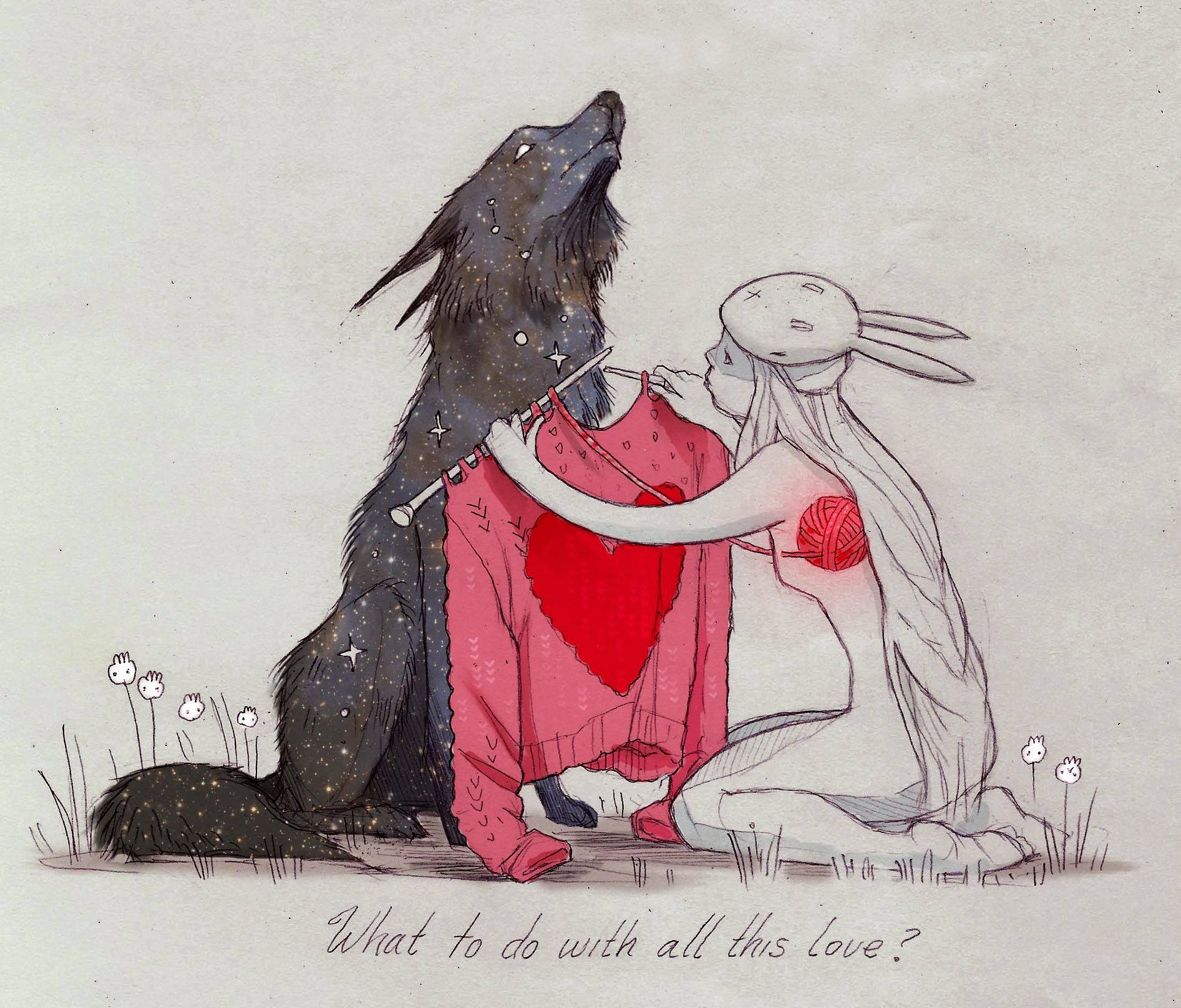Find out why intimacy makes or breaks our health goals.
It was my first year at Burning Man and was, in many ways, a living dream. An event I’d fantasized attending for years was suddenly a reality and I was immersed in the indescribable magic which only a virgin burner could. The downside being: I was miserable much of the time due to conflicts with my ex boyfriend. I’ve heard the playa described as a non-specific amplifier of whatever is going on within us — not unlike psychedelics. For me this meant deep attachment wounds being reopened each time him and I crossed paths.
We had officially ended four months prior after a year and a half of consistent conflict. And as it’s so wisely said, some relationships end so poorly that they never truly end. In my case, four months was not nearly long enough for my nervous system to remain calm at the sight of him.
The first eight months of our relationship had been conveniently long-distance — leaving room for miscommunications and incompatibilities to remain hidden. We were passionate from the start and behaved (while together) as though we were committed partners. We shared an intimate community including close friendships with his housemates and spent enough nights together to store extra toothbrushes for each other. Albeit clearly loving and desiring each other, our entire relationship was one insecure land-mine after another.
We fought constantly and never reached the level of transparency necessary for trust to form — especially since we weren’t monogamous and he took other lovers. We were, as attachment theorists describe, in an anxious-avoidant trap. And this trap held me captive for over six months after our breakup, not even losing it’s grip during an otherwise magical playa experience.

Is your way of loving making you sick?
Despite my background in personal and early child development, it wasn’t until a year after this Burning Man experience that the book Attached was brought to my attention. This book and further research into attachment patterns has opened up a whole new world of understanding and, potentially, more empowered choices for me – should I commit to new ways of loving.
Humans are a social species, completely dependent on each other for basic survival. We are one of the few animals to come out of the womb completely reliant on our external environment for basic development and survival. And this dependence goes on for years, rendering us very vulnerable to those early care providers. Therefore, physical and emotional attachment plays a crucial role in our early development and in our healing capacities throughout our lives.
This is a topic well-worth educating ourselves on if we are seeking individual and global healing.
What is Adult Attachment Theory?
Adult Attachment Theory is a field of study within psychology which combines early childhood attachment patterns with the patterns we develop in our most intimate relationships as adults. Our early childhood attachment patterns are set in place within the first few years of life and tend to show up in our adult strategies for loving those closest to us – specifically romantic and sexual partners.
There are four main patterns of attachment which we adopt from our early years and one core pattern which dominates our adult relationships. Realistically, these patterns are flexible, fall on a spectrum, and can vary depending on life circumstances and the relationship dynamics we’re in. Here are the four types:
Secure: Securely attached adults tend to be the ones who had their basic needs met as small developing children. Their parents were consistent in their affections and boundaries, which allowed them to develop with the safety and support necessary to thrive. As adults, securely attached folks tend to find it easier to be in relationships and have less trauma and recovery time when romantic relationships end. They tend to have a greater awareness of their standards and values and are much less likely to find themselves in dynamics which don’t meet these values and standards. They can give and receive love more easily than an insecurely attached person, so building trust and intimacy is (on average) easier for these types.
Insecure avoidant: Although women can definitely be avoidant as well. avoidance tends to be more prevalent in men. I believe our culture contributes to a higher percentage of male avoidance — providing men with less opportunities to experience & express their emotions, more shame around their emotional needs, and more pressure to play the role as material provider. Unfortunately, avoidance is very common and permeates the dating pool, as avoidant types tend to be single most of the time. Avoidance can manifest in many ways: in one’s personality, behaviors when single, and as “deactivation strategies” with romantic partners. “Deactivation strategy” is a term used by theorists to describe the various ways which avoidants block threatening levels of intimacy or commitment. They rarely date other avoidants because there’s no emotional glue to hold the relationship together. Common patterns to look out for are: having a history of many short-term partners, having unclear boundaries and a lot of “undefined” relationships, lacking closure or getting over an ex, finding fault in their partners, isolation behaviors, or blaming others for their lack of intimacy. Since in reality it’s a spectrum, it can range from mild emotional neglect to severe isolation or even abuse within a relationship dynamic.

Loving an avoidant can feel like perpetually waiting for our love to be met.
Insecure anxious/ambivalent: Anxious types are the opposite of avoidant and tend to need a lot of communication and reassurance in their relationships – especially in the beginning when the connection is fragile. Anxious attachments are very common in families where the parents were permissive, inconsistent, or even neglectful in their parenting styles. Since they also run on a spectrum, they have the potential to be great partners because of their tendency to care for others and to put in the work needed to sustain a relationship. If they’re committed to healing their insecure patterns and finding a partner who meets their needs for intimacy, these types can thrive. However, anxious types are often avoidant magnets (guilty!) so they tend to attract a lot of avoidant partners whom trigger all their familiar childhood wounds. Anxious types often confuse the passionate “hooked” feeling they get from an avoidant with the safety they’re really needing in a sustainable partnership. They can get attached very easily and once invested, will put themselves through hell for a relationship even if it’s clearly unhealthy.
Anxious-Avoidant: This is a less common form which involves both forms of insecure attachment in varying degrees. Anxious avoidant types tend to avoid intimacy, yet they also lash out emotionally in a way that an anxious type would do when they’re safety feels jeopardized. These types tend to look more extreme and can involve abuse or serious co-dependency.
Observing our personal patterns is crucial for changing them.
I want to make it clear that these attachment styles all run on a spectrum and can change with life experience, healing work, and relationship upgrades. I find it essential to healing for us to know what our attachment patterns are at their core… and for us to address the areas which need respect and healing. This often means actively choosing to abstain from dynamics which trigger our default patterns and retraining ourselves emotionally, psychologically, and biologically to be in a safe and healthy dynamic where all our core needs are met.
What often happens is that we get sucked into a dynamic which feels good at first because it is hitting some familiar chords which tell us what love feels like. A lot of times we’re making our romantic and sexual choices from a deeply unconscious place within us which is familiar with a certain energy – even if it’s destabilizing or insecure. On the surface, we might think that we’re creating something different and healthy because the new partner (or even a potential partner) is showing up in a new way. My recommendation is to watch the ways which you react to new potential partners, as your reaction will give you a good indication of the underlying current playing between you.
I’ve been training myself to detect if a guy has some avoidant patterns based on how I react to him when he’s not around and how I react to his COMMUNICATION STYLE. The communication style, for me, is often the dead giveaway as to whether a potential mate is avoidant or not. I’ve come to the clear conclusion that I veer towards an anxious attachment in many of my romantic dynamics and my reactions. But not always.
Unlike many anxious types, I’ve done enough work with myself that I have no problem being alone or enjoying my own company. I don’t generally feel that I need to have a partner to enjoy life or feel inherently valuable. I also don’t cling to all friends and lovers and can assert my boundaries well with 75% of the people in my life. It’s that 25% of romantic partners which get me hooked and kick up the Insecure Kymber. This is when I know a guy has funky boundaries and avoidance patterns I’m getting sucked into.
It’s no one’s “fault,” per se, it’s simply that wounds speaking to wounds in some deeply primal way mimicking early survival patterns. Unless a partner and I come to an intentional agreement to work through our survival wounds together — which is more possible than many realize — we’ll surely fall into an insecure romantic trap and repeat the same traumatic shit from our past. I can go from being fully confident of my own worth, beauty, strength, autonomy, etc… to feeling completely distracted and insecure… all based on who I plug my sexual and romantic energy into. You can see why this impacts our health goals so much.
Health impacts of an insecure attachment
It’s not to hard to correlate the stress of long-term insecure relationships with the development of chronic illness. If you’re health-driven, you already know that stress has numerous health implications, especially in the long-term. When we have insecure attachment patterns prolonged by unresolved childhood trauma, we’re consistently pushing our bodies and psyches into a state of survival stress. Because we want and need intimacy for social and biological reasons, healthy attachments are crucial allies in building resiliency in the face of health and other life challenges.
Here are some of the basic symptoms which get exasperated by insecure attachments:
- anxiety, depression, and problems concentrating
- sexual shame and other problems with sexual functioning and related organ systems
- Lowered immunity and lowered impaired methylation function
- Endocrine disruption in both sex hormones and stress hormones
- High cortisol and sleep disturbances
- Obsessive compulsive behavior
- Social isolation, low self-esteem, body dysmorphia, and other destructive behaviors
- Digestive issues
- Lowered quality of life and overall lower success rates in health goals, motivation, and self-care
How our culture perpetuates insecure attachments

Let’s not beat around the bush – WTF are we doing together?
As you may have gotten if you’ve read some of my other blog posts, I don’t see our current culture to be the healthiest container for deep and lasting healing to unfold. Therefore, we must create our own safe container, our own rules and lifestyles, and unfortunately unlearn a lot of what we’ve been taught since infancy… in the name of healing and growth. This applies as much to how we love as it does to how we eat and how we work.
This culture is obsessed with looking good and keeping up appearances. So, when it comes to intimacy and dating, we’re bombarded with strategies and rules regarding how we should conduct ourselves so as to find our life partner. Here are a few messages I see myself having to unlearn:
- We should keep our insecurities and wounds hidden.
- We should hold back our truths and desires until we’ve reached a certain level of commitment
- We should relate within pre-designed time-frames
- We shouldn’t appear: needy, vulnerable, sensitive, sexually hungry, or too deep.
- We should guard our hearts and make sure that our partners check off ALL our boxes before letting our guard down
- We should hyper-focus on labels and materialistic rituals for signs of value and security
- We should invest in power-struggles and relate based on extrinsic motivators (i.e. I only care if you care)
We’re raised as conquerers, after all. Therefore, love must also be conquered, tamed, and made into a socially acceptable package which will guarantee us lifelong security . However, what a lot of these messages and strategies do is they keep our truths buried and they inhibit us from growing from each love – even potential love – we encounter. Growth is intrinsic to changing our attachment patterns.
What can we do to heal?
If we allow ourselves to be truly honest with how we feel and what we want, be it from a specific person or from a phase in life, we can free ourselves from the attachment traps we get sucked into when we repress our truths. All repression leaves us with is unconscious unmet needs driving us to manipulate a person or situation, either by avoiding or by clinging.
To create this freedom, we must first know what our core attachment patterns are. Adult Attachment Theory can be a great framework for this work and the book I linked at the beginning of this article is a great way to get started. If you’re already in a dynamic with someone whom you suspect is avoidant or you see yourself compelled towards loving avoidant types, this book is another great one which has given me understanding and tools.
And if you favor shorter articles over books, I highly recommend you check out Mark Manson’s article on Attachment Theory here, where he goes into each attachment style and offers suggestions and insights as eloquently as only he can. The important takeaways are:
- Take a painfully honest look at your childhood and your romantic patterns. Get very honest with yourself around your choices.
- Understand that this shit runs deep. We need each other and in a sick culture, it makes sense that that need will get distorted.
- Forgive yourself for all the “mistakes” you’ve made in an earnest attempt to love and have intimacy with others.
- Commit to changing the way that you love so that you can have greater access to health and growth. It’s going to be uncomfortable to love someone who doesn’t trigger familiar patterns.
- Never stop loving just cause you aren’t perfect. We all have mommy daddy issues, and we all still deserve deep love and intimacy.
Now I’d like to hear from you – what did you learn from this article that you might take into your current and future relationships? Make sure to share this article with anyone who might benefit from it. Happy loving!





